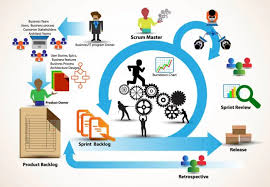Agile Development and Scrum: A Comprehensive Guide
Agile development is a software development approach that emphasizes flexibility, collaboration, and customer satisfaction. One of the most popular frameworks used in agile development is Scrum.
What is Agile Development?
Agile development focuses on iterative and incremental development, where requirements and solutions evolve through collaboration between self-organizing cross-functional teams. This approach allows for quick adaptation to changing requirements and priorities.
What is Scrum?
Scrum is a specific framework within the agile methodology that defines roles, events, and artifacts to help teams work together effectively. It involves breaking down work into manageable chunks called sprints, typically lasting 1-4 weeks, during which a specific set of tasks are completed.
Key Components of Scrum:
- Scrum Master: The facilitator who ensures the team follows the Scrum framework.
- Product Owner: Represents the stakeholders and ensures the team delivers value to the customer.
- Development Team: Self-organizing cross-functional team responsible for delivering increments of working product.
- Sprint Planning: Meeting at the beginning of each sprint to plan the work to be done.
- Daily Standup: Short daily meeting for team members to discuss progress and potential roadblocks.
- Sprint Review: Meeting at the end of each sprint to review and demonstrate completed work.
- Retrospsective: Meeting at the end of each sprint for the team to reflect on what went well and what could be improved.
The Benefits of Agile Development with Scrum
The agile development approach with Scrum offers several benefits, including improved collaboration, faster delivery of working software, increased customer satisfaction, and adaptability to changing requirements. By following this framework, teams can deliver high-quality products that meet customer needs efficiently.
In conclusion, understanding agile development principles and implementing them using frameworks like Scrum can help software development teams become more efficient, responsive, and successful in delivering value to their customers. Embracing agility in software development is key to staying competitive in today’s fast-paced digital landscape.
5 Essential Tips for Effective Agile Development with Scrum
- Hold daily stand-up meetings to keep the team aligned and address any blockers.
- Prioritize tasks in the product backlog based on value and dependencies.
- Use time-boxed sprints to focus on delivering a potentially shippable product increment.
- Encourage collaboration and communication among team members for better efficiency.
- Regularly review and adapt processes to improve team performance and product quality.
Hold daily stand-up meetings to keep the team aligned and address any blockers.
In agile development using Scrum, holding daily stand-up meetings is a crucial practice to ensure team alignment and address any blockers that may impede progress. These short, focused meetings provide an opportunity for team members to share updates on their tasks, discuss any challenges they are facing, and collaborate on solutions in real-time. By maintaining open communication and transparency through daily stand-ups, teams can quickly identify and resolve issues, stay on track with project goals, and foster a culture of continuous improvement.
Prioritize tasks in the product backlog based on value and dependencies.
In agile development using the Scrum framework, it is crucial to prioritize tasks in the product backlog based on their value and dependencies. By focusing on high-value tasks that have dependencies on other work, teams can ensure that they are delivering the most important features first and minimizing delays caused by interdependent tasks. Prioritizing the product backlog in this way allows teams to maximize the value delivered to customers while maintaining a clear understanding of the order in which work should be completed.
Use time-boxed sprints to focus on delivering a potentially shippable product increment.
In Agile development using Scrum, it is essential to utilize time-boxed sprints to concentrate on delivering a potentially shippable product increment. By breaking down the work into manageable chunks and setting specific time limits for each sprint, teams can maintain focus, improve productivity, and ensure continuous delivery of valuable features. This approach not only encourages collaboration and transparency but also allows for quick adaptation to changing requirements, ultimately leading to the creation of high-quality products that meet customer needs effectively.
Encourage collaboration and communication among team members for better efficiency.
Encouraging collaboration and communication among team members is a crucial tip in agile development using Scrum. By fostering an environment where team members openly share ideas, feedback, and progress updates, efficiency can be greatly improved. Effective collaboration ensures that everyone is aligned on project goals and priorities, leading to smoother workflow and faster problem-solving. Clear communication helps to minimize misunderstandings and ensures that tasks are completed in a timely manner. Ultimately, promoting teamwork and open dialogue among team members not only enhances productivity but also strengthens the overall cohesiveness of the team.
Regularly review and adapt processes to improve team performance and product quality.
Regularly reviewing and adapting processes is a crucial tip in agile development using Scrum methodology. By consistently evaluating how the team operates and making necessary adjustments, teams can enhance their performance and product quality. This iterative approach allows for continuous improvement, ensuring that the team remains responsive to changing requirements and challenges. By fostering a culture of reflection and adaptation, teams can optimize their processes to deliver higher-quality products efficiently.




